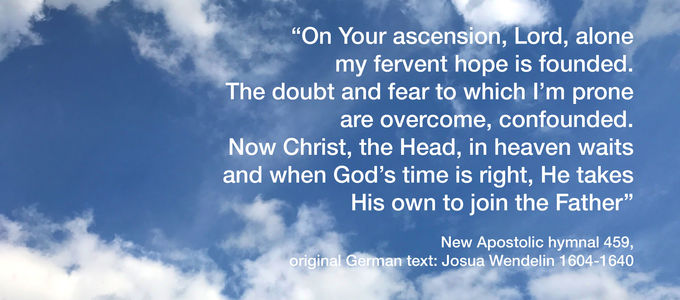
“When I think about Ascension Day, I think about a cloud that slowly makes its way heavenward with the Lord Jesus on top of it,” says fourteen-year-old Michael in Confirmation Class. Fair enough! After all, that is how the Bible describes it.
“When I think about Ascension Day, I think about a cloud that slowly makes its way heavenward with the Lord Jesus on top of it,” says fourteen-year-old Michael in Confirmation Class. Fair enough! After all, that is how the Bible describes it.
“‘But you shall receive power when the Holy Spirit has come upon you; and you shall be witnesses to Me in Jerusalem, and in all Judea and Samaria, and to the end of the earth.’ Now when He had spoken these things, while they watched, He was taken up, and a cloud received Him out of their sight” (Acts 1: 8-9).
Ascension is a matter of faith
“It’s a matter of faith,” people say. Even Christians have their doubts. And yet the ascensio Domini makes sense: the Son of God comes to this earth as a Man, establishes His kingdom here, dies as a Man, resurrects, and goes back into heaven. Many passages in the New Testament speak of these events: the gospels, the Acts, the letters of the Apostles. Even the early church creeds attest to this fundamental principle of faith, which is an inextricable element of Christian eschatology. First there was His birth, then His death, then His resurrection, then the strengthening of His church, then the Ascension. Everything is going according to plan.
Everything according to plan
We too live between these two poles: at times we find ourselves at the lowest of depths, and then we are lifted up to the greatest heights again. As Christians we seek strength from God. At times this is purely an existential matter for us. There are so many evil days in which we might experience illness, suffering, grief, trauma, pain, hopelessness, misery. There are times when we are without courage, without future, and without joy. In response to these, the message of the Ascension offers a comforting message: you will not always remain in this state of misery! You are on your way up! On the way to heaven! Anyone who forgets about the Ascension will miss out on the happy end. Let us keep our eyes directed heavenward. The surprise is waiting for us there: looking up—ascension—safety and security.
Looking up gives us strength
Just be honest with yourself: you are bitterly in need of this perspective! This gives your life the resilience it needs. Looking beyond the horizon makes us courageous and curious. Where is your heaven? Take a look, make your way, and draw new strength. The spiral of life moves upward and heavenward, not downward. “And a cloud received Him out of their sight”—what a beautiful statement!
Key term: the ascension of Christ
On the calendar, the ascension of Christ occurs forty days after Easter. This has already been the case since the fourth century AD. The context of this event is related with special clarity in the gospels according to Mark and Luke, but is also described in the first chapter of Acts: a cloud bears the Risen One up into heaven. And from there follow the images we know. Ascension shows us the possibility of change—from this lower plane to a higher estate, a transition from this earthly existence toward a future with God. Those who die with Christ will also resurrect with Him—only to ascend with Him as well.
Photo: Oliver Rütten




